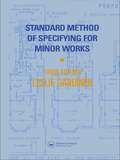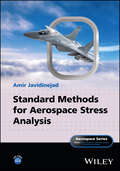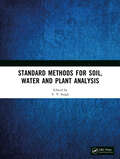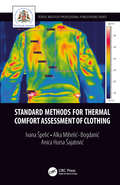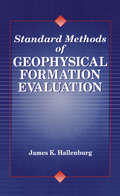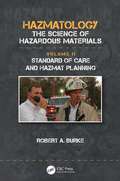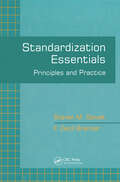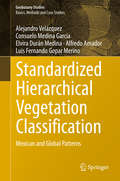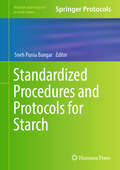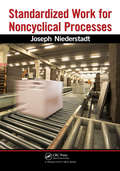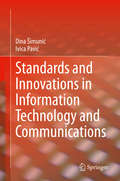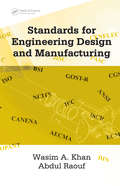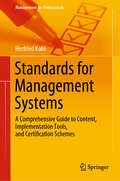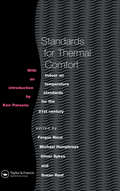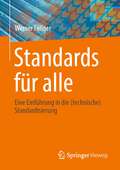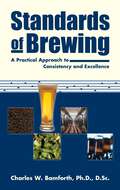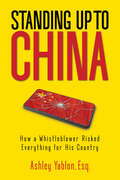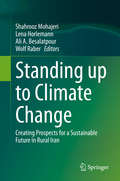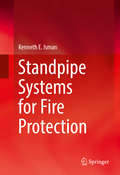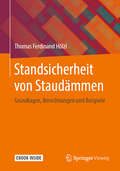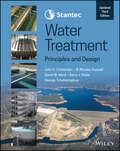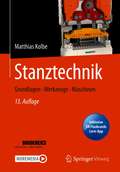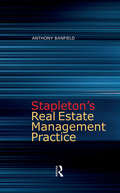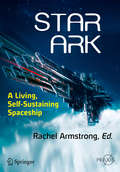- Table View
- List View
Standard Method of Specifying for Minor Works
by L. GardinerThere is no widely recognized method for producing specifications of repair, improvement and conversion work, yet consistent documentation is fundamental to good client communications and consistent pricing. This new edition of a highly regarded reference work sets out a method of producing specifications for minor works by prescribing the common terminology and a logical sequence for scheduling work.
Standard Methods for Aerospace Stress Analysis (Aerospace Series)
by Amir JavidinejadStandard Methods for Aerospace Stress Analysis Create safer, more reliable planes with this crucial guide Aerospace Stress Analysis is the field of research and engineering that evaluates stresses and strains on aerospace structures. By analyzing how different materials and components respond to forces, it helps aerospace engineers build for structural integrity and safety. Combining mathematical and computational models with experimental techniques, it’s a crucial component of developing viable aerospace technologies. Standard Methods for Aerospace Stress Analysis offers a thorough, practical overview of the structural and stress analysis of both principal and secondary aircraft structures. It covers both fundamental concepts and advanced computational methods, along with key applications. With coverage of both interior and exterior structures, it’s a one-stop shop for all major aspects of stress analysis. Standard Methods for Aerospace Stress Analysis features: Step-by-step examples for every aircraft section Detailed discussion of methods including Finite Element Analysis An overview of key information on static, fatigue, damage tolerance, buckling, and more Standard Methods for Aerospace Stress Analysis is ideal for professional mechanical and aerospace engineers working in the aircraft or space industries, as well as students in the field.
Standard Methods for Soil, Water and Plant Analysis
by Y. V. SinghWritten out of the author’s experience at the laboratories in the Institute of Agricultural Sciences at Banaras Hindu University, this book addresses the need for identifying and addressing deficiencies in soil, water, and plants. Techniques to evaluate soil fertility constraints based on soil chemical extraction and analysis of the plants that grow on such soils are discussed. This book also presents standard methods from different sources – these have been compiled and adapted for routine analyses in the Indian subcontinent.This book is aimed at aimed at research scientists, technicians, and students.Print edition not for sale in South Asia (India, Sri Lanka, Nepal, Bangladesh, Pakistan or Bhutan)
Standard Methods for Thermal Comfort Assessment of Clothing (Textile Institute Professional Publications)
by Ivana Špelić Alka Mihelić-Bogdanić Anica Hursa ŠajatovićProviding detailed analysis of the thermal comfort assessment of clothing as the basis for developing standards, this book discusses the thermal protective role of clothing as a way of modelling heat transfer from the body, general thermal regulation of humans, and the importance of globally accepted test methods and standards to improve quality. New materials and discoveries in the study of thermal comfort necessitate the need for standard improvements and update. The development of international standards and the unification of testing methods is of crucial significance to ensure cost reduction and health protection. The book promotes instruments, methods, implementation of unified specifications, and the definition of standards so that a clear quality management system can be established, for both production systems and testing methods. It discusses standards in ergonomics of the thermal environment, clothing thermal characteristics, and subjective assessment of thermal comfort, which allows for systematic control of the measuring methods and the services and final products that are distributed on the global market. This book is aimed at industry professionals, researchers, and advanced students working in textile and clothing engineering, comfort testing, and ergonomics.
Standard Methods of Geophysical Formation Evaluation
by James K. HallenburgThese three works cover the entire field of formation evaluation, from basic concepts and theories, through standard methods used by the petroleum industry, on to new and exciting applications in environmental science and engineering, hydrogeology, and other fields. Designed to be used individually or as a set, these volumes represent the first comprehensive assessment of all exploration methodologies. No other books offer the breadth of information and range of applications available in this set.
Standard of Care and Hazmat Planning
by Robert A. BurkeWritten by a hazardous materials consultant with over 40 years of experience in emergency services, the five-volume Hazmatology: The Science of Hazardous Materials suggests a new approach dealing with the most common aspects of hazardous materials, containers, and the affected environment. It focuses on innovations in decontamination, monitoring instruments, and personal protective equipment in a scientific way, utilizing common sense, and takes a risk-benefit approach to hazardous material response. This set provides the reader with a hazardous materials "Tool Box" and a guide for learning which tools to use under what circumstances.Emergency responders are bound to a Standard of Care for response to hazardous materials incidents, based on federal law, regulations, and consensus standards. Volume Two, Standard of Care and Hazmat Planning, presents the hazardous materials legal issues and background on the Hazmat Standard of Care, including incidents where Care was violated and the repercussions felt. FEATURES Uses a scientific approach utilizing analysis of previous incidents Suggests guidance in developing plans for hazmat response Provides an exploration of laws, regulations, and standards Outlines the elements of Standard of Care response Includes case studies and in-depth history of Standard of Care response
Standardization Essentials: Principles and Practice
by Steven M. Spivak F. Cecil BrennerThis ready reference surveys the discipline of standards and standardization, defining common terms, clarifying descriptions, describing how standards could be used to restrain trade, and explaining how international trade is stimulated by the due process provisions of standards writing organizations. Containing real-world examples provided by experienced standards professionals, Standardization Essentials is a vital, forward-looking reference for mechanical, civil, electrical and electronics, materials, chemical, mineral, cost, quality, reliability, industrial, developmental, safety, forensic, and consulting engineers; standards managers; architects; project managers; upper-level undergraduate, graduate, and continuing education students in these disciplines.Crystallizes the essential role that standards play in strategic standardization management, purchasing, contractual agreements, and international trade!Covering costs, benefits, limitations, uses, and abuses of standardization programs, Standardization Essentials Considers whether standards build or bar trade and the use of international standards to leverage world markets Presents a case study of conformity assessment related to international technical trade barriers Focuses on consumer safety standards for automobile tires and other products Addresses implementation of ISO 9000 and ISO 14000 management system standards in industry Highlights voluntary (nongovernmental) and mandatory (governmental) standards and regulations developed by a variety of organizations Reveals competition, incongruities, and harmonization among national and international standards
Standardized Hierarchical Vegetation Classification
by Alejandro Velázquez Consuelo Medina García Elvira Durán Medina Alfredo Amador Luis Fernando Gopar MerinoThis book outlines the transitions between cultured and natural land cover/vegetation types and their implications in the search for alternatives to reverse the trend of anthropogenic environmental degradation. It also elaborates on the proposed "standardized hierarchical Mexican vegetation classification system" and geobotanical mapping, a critical transversal environmental issue. The first chapter consists of an historical review of the common approaches to the study of vegetation both in Mexico and in other regions of the world. The second chapter concisely analyzes the existing schools of thought that have led to the development of vegetation classification systems based on physiognomic, structural and floristic approaches. The focal point of the book is the "standardized hierarchical Mexican vegetation classification system" (SECLAVEMEX - "Sistema jerárquico estandarizado para la clasificación de la vegetación de México"). Chapter 3 describes the system's organizational levels along with the criteria defining them and the nomenclatural basis for the denomination of each type of vegetation. It also includes a series of tables explaining and precisely defining the meaning of each concept, criterion, character and element used to help readers successfully identify the type of vegetation in a determined area. The fourth chapter highlights SECLAVEMEX's inclusive character as evidenced through its compatibility with other systems currently used around the globe. Three concepts are critically reviewed: land cover, land use and vegetation. These are often the study subject of the contrasting disciplines geography, agronomy and ecology, which all rely upon plant species assemblages. As such, the final chapter focuses on a critical transversal environmental issue - geobotanical mapping. Geobotanical mapping offers a baseline for land cover/use planning and provides critical information on ecological, economic and cultural attributes, which can be used as a basis for environmental-policy decisions. The proposed SECLAVEMEX was applied to Mexico as an example of land cover, land use and vegetation patterns intermingling as the result of a long human influence. SECLAVEMEX, however, can be adapted and hopefully adopted globally as a baseline for consistently comparing geobotanical patterns and their transitions.
Standardized Procedures and Protocols for Starch (Methods and Protocols in Food Science)
by Sneh Punia BangarThis volumes provides protocols and methodology for understanding starch and its practical applications. Chapters guide readers through starch granule morphology, transmission electron microscope,amylose, amylopectin, chromatographic methods, X-rays by crystals,physical modification methods, and provides a comprehensive discussion of enzymatic modifications of starch. ritten in the format of the Methods and Protocols in Food Science series, the chapters include an introduction to the respective topic, list necessary materials and reagents, detail well-established and validated methods for readilyreproducible laboratory protocols, and contain notes on how to avoid or solve typical problems. Authoritative and cutting-edge, Standardized Procedures and Protocols for Starch aims to ensure successful results in the further study of this vital field.
Standardized Work for Noncyclical Processes
by Joseph NiederstadtWhile it is a given that most Lean companies adopt methods to standardize cyclical activities, they often fail to apply the same rigor to noncyclical work, believing that it cannot be measured. Standardized Work for Noncyclical Processes cuts to the core of this mistaken belief and shows you how to measure nonrepeating job processes and eliminate waste associated with noncyclical activities. Taking a hands-on approach reflective of his time as an operator on the line, Joseph Niederstadt lays out the methods he has instituted successfully in more than 30 factories around the world. He defines and details a proven process for building consistent quality products at reduced costs, and includes coverage of activities involving multiple machine job setters, maintenance, stockers, and quality auditors. When implemented correctly this method can help you increase utilization to 85 percent through intelligent data collection.Presenting a wealth of process charts and visual reference tools, the book illustrates how to: Identify abnormalities and waste Foster teamwork and knowledge sharing Promote a safe work environment Ensure a balanced workload Establish a baseline for continuous improvements Throughout the text, the author references blank forms and offers numerous examples of what the forms should look like when populated with the proper data. The downloadable resources include e-versions of all the forms, as well as color versions of images found in the text. "Where there is no standard, there is no improvement."—Taichi Ohno, Toyota
Standards and Innovations in Information Technology and Communications
by Dina Šimunić Ivica PavićThis book gives a thorough explanation of standardization, its processes, its life cycle, and its related organization on a national, regional and global level. The book provides readers with an insight in the interaction cycle between standardization organizations, government, industry, and consumers. The readers can gain a clear insight to standardization and innovation process, standards, and innovations life-cycle and the related organizations with all presented material in the field of information and communications technologies. The book introduces the reader to understand perpetual play of standards and innovation cycle, as the basis for the modern world.
Standards for Engineering Design and Manufacturing
by Wasim Ahmed Khan S.I. RaoufMost books on standardization describe the impact of ISO and related organizations on many industries. While this is great for managing an organization, it leaves engineers asking questions such aswhat are the effects of standards on my designs? andhow can I use standardization to benefit my work? Standards for Engineering Design and Manuf
Standards for Management Systems: A Comprehensive Guide to Content, Implementation Tools, and Certification Schemes (Management for Professionals)
by Herfried KohlThis book guides readers through the broad field of generic and industry-specific management system standards, as well as through the arsenal of tools that are needed to effectively implement them. It covers a wide spectrum, from the classic standard ISO 9001 for quality management to standards for environmental safety, information security, energy efficiency, business continuity, laboratory management, etc. A dedicated chapter addresses international management standards for compliance, anti-bribery and social responsibility management. In turn, a major portion of the book focuses on relevant tools that students and practitioners need to be familiar with: 8D reports, acceptance sampling, failure tree analysis, FMEA, control charts, correlation analysis, designing experiments, estimating parameters and confidence intervals, event tree analysis, HAZOP, Ishikawa diagrams, Monte Carlo simulation, regression analysis, reliability theory, data sampling and surveys, testing hypotheses, and much more. An overview of the necessary mathematical concepts is also provided to help readers understand the technicalities of the tools discussed. A down-to-earth yet thorough approach is employed throughout the book to help practitioners and management students alike easily grasp the various topics.
Standards for Thermal Comfort: Indoor air temperature standards for the 21st century
by M. Humphreys F. Nicol S. Roaf O. SykesCurrent Standards for Indoor Air Temperature are inappropriate in many regions of the world. This forces designers to use highly serviced buildings to achieve air temperatures that accord with the standards to the detriment of the local and global environment. Standards for Thermal Comfort brings together contributions from around the world, reflecting new approaches to the setting of standards which can apply to all climates and cultures.
Standards für alle: Eine Einführung in die (technische) Standardisierung
by Werner FellnerDieses Buch soll ein Bewusstsein wecken hinsichtlich der Notwendigkeit und Vorteile von innerbetrieblichen (technischen) Standards: Jedes Unternehmen hat das Ziel, effizient, innovativ und wirtschaftlich zu produzieren. Für eine effiziente Organisation und Erfüllung von zu berücksichtigenden Anforderungen können Standards maßgeblich zum Erfolg eines Unternehmens beitragen. Zu Beginn des Buches werden zu berücksichtigende Randbedingungen und Argumente für innerbetriebliche (technische) Standards aufgezeigt. Es folgen mögliche Einteilungskriterien, Definition und Grundlagen von Standards sowie deren Gestaltung und praktischen Anwendung. Im Anschluss wird das generelle Management und die Rollen im Standardisierungsprozesses beschrieben. Für eine konkrete Umsetzung in Unternehmen werden abschließend beispielhaft die grundlegenden und notwendigen Festlegungen der Standardisierung vorgestellt. Unterstützt durch viele Grafiken hilft dieses Buch beim Aufbau einer Standardisierung bzw. bei der Analyse bestehender innerbetrieblicher Standards und verschafft überraschende Einblicke in die Welt der Normen.
Standards of Brewing: Formulas for Consistency and Excellence
by Charles W. BamforthStandards of Brewing covers an essential topic for today&’s brewers: consistent production of quality product. With distribution expanding and competition intense, no brewery can afford to release product for distribution unless it is confident the beer will meet consumer expectations-even months after production. Bamforth covers the principles and practices of brewery quality so that brewers can establish or audit their own programs and procedures for producing consistent, high quality beer.
Standing Up to China: How a Whistleblower Risked Everything for His Country
by Ashley YablonWhat would you do if your ambitious career suddenly transformed into a deadly game of international espionage? A true-life thriller equal to that of a heart-stopping John Grisham novel, Ashley Yablon's story takes readers into the dark crevices of deceit and corporate greed of one of the world's most powerful Chinese telecom giants. As the freshly minted General Counsel for telecom company ZTE, Yablon uncovers an illegal scheme selling billions of dollars' worth of surveillance equipment to embargoed countries. If left unchecked, these transactions could threaten the security of the United States at the highest levels. Instead of turning a blind eye, Yablon risks everything, including his life and career, to uphold justice - leading him down a course of personal and professional destruction. In this modern-day story of David and Goliath, Yablon goes head-to-head with some of the most dangerous and powerful Chinese crime bosses in the world.
Standing up to Climate Change: Creating Prospects for a Sustainable Future in Rural Iran
by Shahrooz Mohajeri Lena Horlemann Ali A. Besalatpour Wolf RaberIn Iran, climate change combined with low adaptation capacity has an unparalleled impact on eco-systems as well as human livelihoods. The Roodasht region, in the lower part of the Zayandeh Rud basin in Central Iran, is severely affected by water scarcity, desertification and land degradation. This book describes the effects this has on the environment and society, analyzes the degree of vulnerability and suggests possible ways to improve land and water management. This book provides comprehensive and interdisciplinary insights into the environmental and social situation in the region, as well as possible solutions to deal with the current challenges. Written by German and Iranian scientists, NGO staff and government officials and bridging the gap between research and practical implementation, the book not only enhances our understanding of climate change and desertification, but also raises public awareness and promotes knowledge transfer between disciplines.
Standpipe Systems for Fire Protection
by Kenneth E. IsmanThis important new manual goes beyond the published NFPA standards on installation of standpipe systems to include the rules in the International Building Code, municipal fire codes, the National Fire Code of Canada, and information on inspection, testing, and maintenance of standpipe systems. Also covered are the interactions between standpipe and sprinkler systems, since these important fire protection systems are so frequently installed together. Illustrated with design examples and practical applications to reinforce the learning experience, this is the go-to reference for engineers, architects, design technicians, building inspectors, fire inspectors, and anyone that inspects, tests or maintains fire protection systems. Fire marshals and plan review authorities that have the responsibility for reviewing and accepting plans and hydraulic calculations for standpipe systems are also an important audience, as are firefighters who actually use standpipe systems. As a member of the committees responsible for some of these documents, Isman also covers the rules of these standards and codes as they are written, but also provides valuable insight as to the intent behind the rules. A noted author and lecturer, Professor Isman was an engineer with the National Fire Sprinkler Association (NFSA), is an elected Fellow of the Society of Fire Protection Engineers (SFPE), and currently Clinical Professor in the Department of Fire Protection Engineering at University of Maryland.
Standsicherheit von Staudämmen: Grundlagen, Berechnungen und Beispiele
by Thomas Ferdinand HölzlDie Standsicherheit von Staudämmen ist ein komplexer Ausschnitt aus dem Bereich der Geotechnik. Mit diesem Buch wird ein Einblick ist das umfangreiche Themengebiet gegeben und es soll als Nachschlagewerk für die praktische Anwendung dienen, sowie bei speziellen Problemstellungen auf geeignete weiterführende Literatur bzw. Regelwerke hinweisen. Im ersten Teil werden die theoretischen Grundlagen aufbereitet und im zweiten Teil sind praktische Beispiele berechnet sowie eine Parameterstudie dargestellt, um wesentliche Zusammenhänge zu veranschaulichen.
Stanley in Space (Flat Stanley #3)
by Jeff BrownThe President of the United States has chosen Stanley Lambchop and his family to become the first humans to fly in the Star Scout, a new top-secret spaceship. Stanley's most exciting adventure is about to begin. He'll meet the Queen of England, have a birthday party in outer space, and save a whole planet of aliens from danger. Oh, that Stanley!
Stantec's Water Treatment: Principles and Design
by John C. Crittenden David W. Hand R. Rhodes Trussell George Tchobanoglous Kerry J. HoweThe updated third edition of the definitive guide to water treatment engineering, now with all-new online content Stantec's Water Treatment: Principles and Design provides comprehensive coverage of the principles, theory, and practice of water treatment engineering. Written by world-renowned experts in the field of public water supply, this authoritative volume covers all key aspects of water treatment engineering, including plant design, water chemistry and microbiology, water filtration and disinfection, residuals management, internal corrosion of water conduits, regulatory requirements, and more. The updated third edition of this industry-standard reference includes an entirely new chapter on potable reuse, the recycling of treated wastewater into the water supply using engineered advanced treatment technologies. QR codes embedded throughout the book connect the reader to online resources, including case studies and high-quality photographs and videos of real-world water treatment facilities. This edition provides instructors with access to additional resources via a companion website. Contains in-depth chapters on processes such as coagulation and flocculation, sedimentation, ion exchange, adsorption, and gas transfer Details membrane filtration technologies, advanced oxidation, and potable reuse Addresses ongoing environmental concerns, pharmacological agents in the water supply, and treatment strategies Describes reverse osmosis applications for brackish groundwater, wastewater, and other water sources Includes high-quality images and illustrations, useful appendices, tables of chemical properties and design data, and more than 450 exercises with worked solutionsStantec's Water Treatment: Principles and Design, Updated Third Edition remains an indispensable resource for engineers designing or operating water treatment plants, and is an essential textbook for students of civil, environmental, and water resources engineering.
Stanztechnik: Grundlagen - Werkzeuge - Maschinen
by Matthias KolbeIn diesem Lehr- und Fachbuch finden Sie den aktuellen Stand von Verfahren, Werkzeugen sowie Maschinen und Anlagen der Stanztechnik. Gestaltungsregeln und Kennwerte aus der Praxis geben Hilfestellung bei der Konstruktion von Werkzeugen. Die rechnerische Bestimmung der Einflussgrößen, werkstofftechnische Grundlagen und funktionale Zusammenhänge unterstützen bei der Auswahl von Maschinen. Durch die zahlreichen Berechnungsbeispiele und vollständigen Lösungswege eignet sich dieses Buch sehr gut für das Selbststudium. Völlig neue Kapitel beschreiben eine Erweiterung der Antriebstechnik bei Hochleistungspressen, die Stanzbiege-Technik, die optische Überwachung von Stanzwerkzeugen und -prozessen, das Bürsten sowie das Beschichten von Vorschubwalzen. Es wurde eine Vielzahl weiterer Inhalte, beispielsweise zur Feinstanz- und Schmiertechnik aktualisiert und Bilder aussagekräftiger dargestellt.Zusätzliche Fragen per App: Laden Sie die Springer-Nature-Flashcards-App kostenlos herunter und nutzen Sie exklusives Zusatzmaterial, um Ihr Wissen zu prüfen.
Stapleton's Real Estate Management Practice
by Anthony BanfieldPreviously known as Estate Management Practice, the fourth edition of this work has been renamed to reflect current market practice and to embrace the discipline of corporate real estate. This book provides a comprehensive study of the management of urban property and is divided into three parts. Part one considers the diverse nature of the many types of estates and different aspects and interpretations of the management task. Part two concentrates on the management of leased property, repairs, service charges and rent reviews and the statutory framework within which the landlord and tenant relationship has developed. Part three is concerned with the positive management covering both technical skills, such as portfolio performance, and the professional practice environment in which they are exercised. Stapleton’s Real Estate Management Practice is written both for advanced students and practitioners. It provides a firm basis for management affecting the decision-making hierarchy from tenant to property, to portfolio, to proprietary unit. While retaining the format of previous editions, it has been updated to reflect the many changes in the law, practice, technology and the market place since the previous edition. In addition, this new edition highlights factors that influence the enhancement of different types of property and the various strategies involved in managing properties from both owners’ and occupiers’ point of view.
Star Ark
by Rachel ArmstrongAs space ventures have become more numerous, leading scientists and theorists have offered ways of building a living habitat in a hostile environment, taking an 'ecosystems' view of space colonization. The contributors to this volume take a radical multi-disciplinary view of the challenge of human space colonization through the ongoing project Persephone. This book fundamentally challenges prevalent ideas about sustainability and proposes a new approach to resource austerity and conservation and providing truly sustainable approaches that are life-promoting. Readers will learn the details of the plans for Persephone - a real project that is part of the company Icarus Interstellar's plans for the design and engineering of a living interior on a worldship to be constructed in Earth's orbit within 100 years. Although the timeframe itself is only an estimate, since it is contingent on many significant developments, including funding and technological advances, the industry consensus is that within 100 years we will see manned space exploration beyond our solar system. This notion is shared by organizations such as the Initiative for Interstellar Studies and the DARPA-funded 100-year starship project. This book specifically develops the principles for the construction of a living habitat within a worldship - a multi-generational starship that contains its own world that supports colonists as it travels across great distances between stars at a speed much slower than light. Far from being a sterile industrial setup, such as the ISS, or even being a bucolic suburbia as proposed by Gerard O'Neill in the 1970s, this worldship will provide the pre-conditions for sustaining life beyond Earth's environment, which may also lead to the evolution of non-terrestrial ecologies. Drawing on the principles of ecopoiesis and insights offered by the Biosphere 2 experiment that demonstrated what we have to learn about ecosystem construction, this book proposes first designing the soils of such a space. It should then be possible to set up the conditions that a first generation of colonists may experience in leaving our solar system to find new worlds to settle - perhaps in spreading life throughout the universe. Although the book takes a unique view of ecology and sustainability within the setting of a traveling starship it is equally concerned with the human experience on artificial worlds. Chapters come from a range of multi disciplinary thinkers who shed light on the brave new future ahead from different angles.
